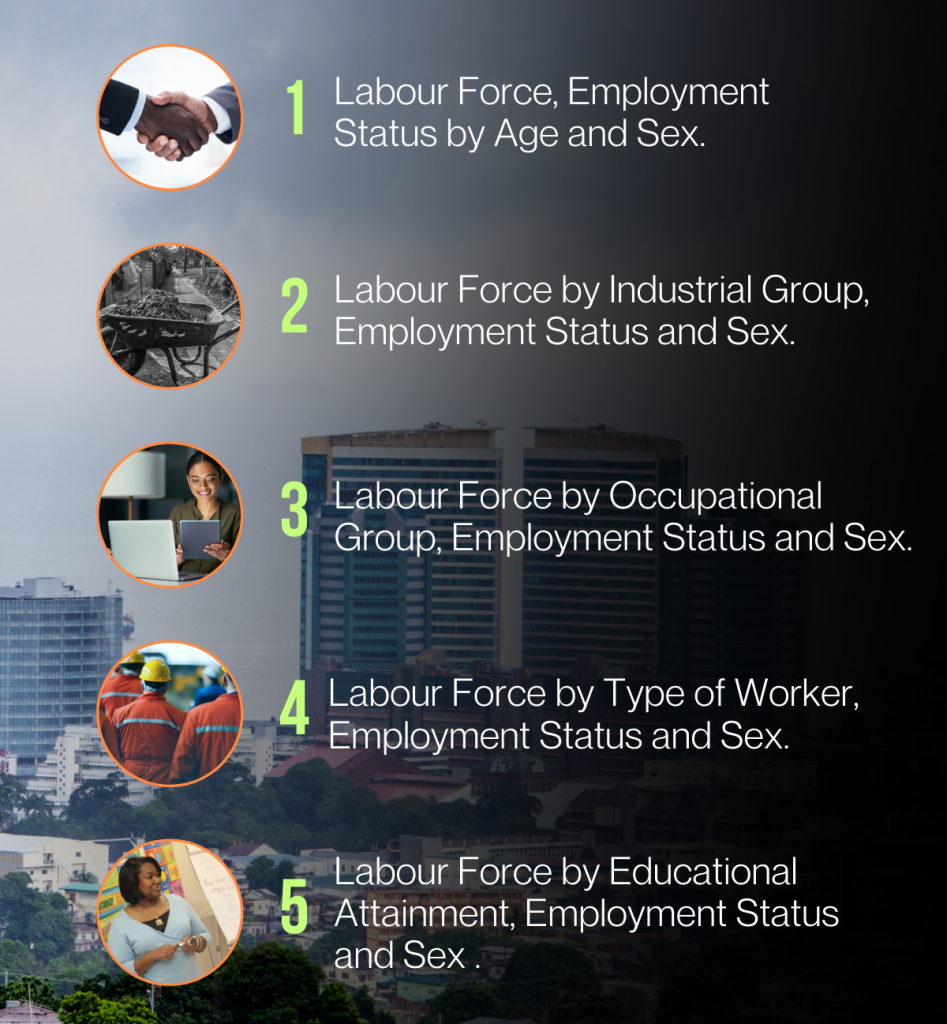
The Continuous Sample Survey of Population (CSSP) is a multi-purpose household survey with it’s primary objective being to provide up-to-date data on the Labour Force characteristics of the population of Trinidad and Tobago on a continuing basis. It is also a vehicle for collecting data on other subjects of interest to both Government and Private Agencies for the purposes of planning and formulating policies.

Indicators
Participation Rate
2025 Q2
Employment-to-Population Ratio
2025 Q2
Unemployment Rate
2025 Q2
TOTAL LABOUR FORCE
| Indicator | 2024_Q4 | 2025_Q1 | 2025_Q2 |
|---|---|---|---|
| Total Non-institutional population 15 years old and over | 1,082,100 | 1,081,900 | 1,082,500 |
| Total labour force | 605,400 | 587,700 | 596,900 |
| Persons with jobs | 572,300 | 558,900 | 574,100 |
| Total unemployed | 33,000 | 28,900 | 22,600 |
| Persons without jobs and seeking work | 26,400 | 25,800 | 18,000 |
| Other unemployed | 6,600 | 3,200 | 4,700 |
| Labour Force Participation Rate (%) | 55.9 | 54.3 | 55.1 |
| Unemployment Rate (%) | 5.5 | 4.9 | 3.8 |
| Not in Labour Force | 476,800 | 494,200 | 485,700 |
| Source: Central Statistical Office |
youth unemployment(15-24)
| Indicator | 2024_Q4 | 2025_Q1 | 2025_Q2 |
|---|---|---|---|
| Male | 12.9% | 7.4% | 8.2% |
| Female | 11.7% | 9.6% | 14.6% |
| Both Sexes | 12.4% | 8.5% | 10.4% |
| Source: Central Statistical Office |
Quartely Youth(15-24) Labour Force Status

CONCEPTS

Coverage and Classification
GEOGRAPHIC COVERAGE
National coverage
UNIT OF ANALYSIS
standard occupational classification

Data Collection
FREQUENCY OF DATA COLLECTION
sample design
topics covered
Demographic characteristics – age, sex, ethnic group, education, place of birth, marital status
Economic activity – type of worker, occupation, industry, hours worked, income
Housing – tenancy, type of dwelling, toilet facilities, water supply, source of lighting

Labour Force Survey (LFS) Bulletins
Latest Release
In Quarter 2 2025, the average number of persons with jobs for all sectors was 574,100. Compared to the 1st Quarter of 2025, the overall average employment across all industries increased by 2.7%.
A quarter-on-quarter comparison (2025 Q1 over 2025 Q2) revealed that the average number of persons without jobs and seeking work decreased by 30.2%. A year-on-year comparison (2024 Q2 over 2025 Q2) revealed that the average number of persons without jobs and seeking work decreased by 22.1%
(October 10th, 2025)
NB. The Figures in these reports are rounded to the nearest hundred. Totals shown may not always agree with their components due to the effect of rounding.
Quarterly Bulletin
Quarterly Time Series
Annual Time Series


Persons with jobs by Monthly Income Group 2014-2024
The Economically Inactive Population (Out of the Labour Force)
This general category consists of:
- (i) Persons who explicitly stated that they did not want work
- (ii) Students (full time)
- (iii) Persons engaged in Home Duties
- (iv) The Retired
- (v) The Disabled
- (vi) Old Age Pensioners
- (vii) Other persons, e.g. mentally challenged, inmates of prisons, hospitals, mental institutions etc.

Keywords: labour force, unemployment rate, cssp, income, employed, statistics

 Metadata
Metadata
Methodology and Usefulness
Concepts and Definitions
A job is defined as any economic activity in which a person is engaged for pay in cash or kind, regardless of the duration of work, since work takes precedence over any other activity.
Scope
Content: Non-Institutional population of individuals who are 15 years of age or older and are members of non-overlapping private households
Units: Private Households within private dwellings
Extent (Scope): Enumeration Districts (EDD) within Wards/Parishes of Counties in the Republic of Trinidad and Tobago
The CSSP Labour Force Household survey is national in scope. The sample is representative of fourteen and four Domains of Stratification in the islands of Trinidad and Tobago respectively. In the case of Tobago, over-sampling of households is done deliberately in order to allow for the quarterly estimation of labour force characteristics for Tobago as a separate entity.
Note: An Enumeration District (ED) is the smallest geographic unit into which the country is divided in order to facilitate the conduct of household surveys and censuses. It contains on average, approximately 200 households in the urban areas and approximately 120 households in the rural areas. EDD are non-overlapping and are bounded primarily by easily identifiable features.
Time (Reference Period): A specific week within a given month, which is called the survey reference week. For each calendar month of every quarter there are two such reference weeks.
Classification
For all jobs, the employed is classified into occupational and industrial groupings according to ISCO and ISIC respectively. The employed is also classified by the size of business in which s/he is employed and by the number of hours worked during the reference period.
Sheet tabs in bulletin
Source of data
Data on employment are obtained exclusively from monthly household surveys of the Continuous Sample Survey of Population (CSSP). Samples of households are drawn from a sample Frame of Non-institutional households. The sample frame of households is updated after every decennial census. The latest revision of the frame was based on the 1990 Population and Housing Census.
Statistical Techniques
The CSSP household survey is based on a stratified cluster design in which households are sampled in the same proportions that they are allocated to strata. The sampling of clusters of households is done in two stages. At the first stage, by the process of repeated systematic selection, PSUs are selected with probability approximately proportional to a size measure.
The size measure is the number of clusters of households within a primary unit, where the size of a cluster is approximately equal to five households. At the second stage, by the process of systematic selection, households are selected with probability inversely proportional to size. The rate of sampling households in Trinidad is 1 in 120, whereas the rate of sampling households in Tobago is 1 in 75. However, within each island stratum the sample of households is self-weighted.
The grand sample of first stage PSUs is arranged into three sub-samples. In order to improve the efficiency of the design so that one can measure changes from one period to the next and, at the same time, measure the current levels of labour force characteristics, the following procedure was adopted:One third of the sample was retained from the previous quarter in the quarter under review to measure the changes between quarters. Another third of the sample was recalled from the corresponding quarter of the previous year to measure changes over a year for corresponding quarters.
Finally, the last third of the sample was drawn anew to measure current estimates. In addition to the above, sub-samples were arranged in a Latin square formation in order to control sample variability arising from two sources of variability:Variability due to monthly seasonal factors of labour force characteristics Variability due to geographical location of the labour force Estimation of the number of persons employed is done by gender specifics.
Data are expanded to population levels by means of weighting ratio estimates of characteristics of interest to number of persons in the sample by an estimate of the number of persons in the population aged 15 and over. The estimate of the number of persons in the population aged 15 and over, by gender, which is obtained from a source that is independent of the labour force survey, is centered at the middle of each quarter.
Estimate of population based on the independent source is crossed checked against estimate of population based on expanding the sample by the inverse of the sampling fraction adjusted for non-response. Estimates of missing data are not made. Missing data are recorded as “no
Periodicity and Timeliness
Periodicity
Quarterly.
Timeliness
Currently, the elapse of time between the dissemination of the data and the end of the second survey reference week of the last month in the quarter under review is approximately twenty (20) weeks.
Data Revision
Identification of preliminary and/or revised data
Data is clearly identified as provisional, preliminary, revised or final data upon dissemination
Using Official Statistics for SDGs




Indicators
- 8.3.1 Proportion of informal employment in total employment, by sector and sex
- 8.5.1 Average hourly earnings of female and male employees, by occupation, age and persons with disabilities
- 8.5.2 Unemployment rate, by sex, age and persons with disabilities
- 8.6.1 Proportion of youth (aged 15-24 years) not in education, employment or training
- 8.b.1 Existence of a developed and operationalized national strategy for youth employment, as a distinct strategy or as part of a national employment strategy
- 9.2.2 Manufacturing employment as a proportion of total employment
- 10.4.1 Labour share of GDP
